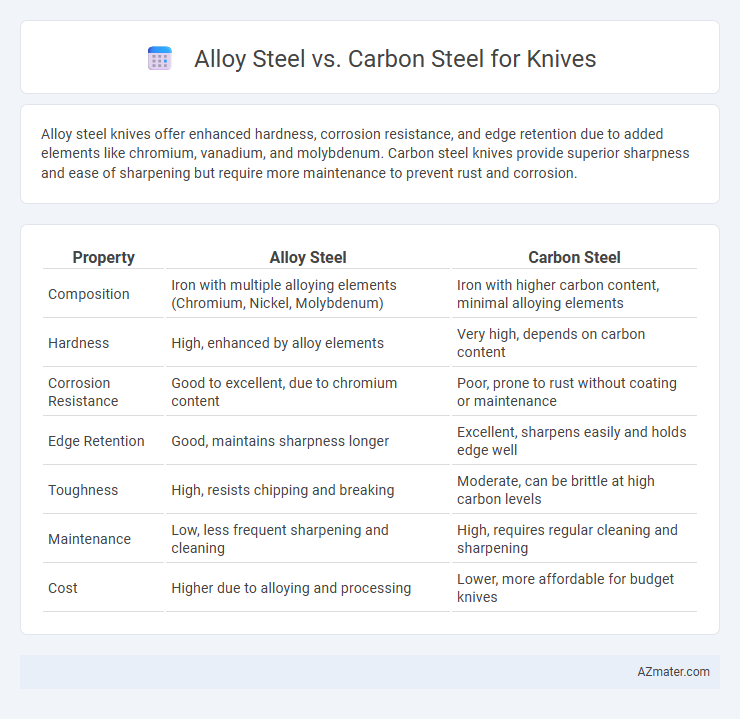Alloy steel knives offer enhanced hardness, corrosion resistance, and edge retention due to added elements like chromium, vanadium, and molybdenum. Carbon steel knives provide superior sharpness and ease of sharpening but require more maintenance to prevent rust and corrosion.
Table of Comparison
| Property | Alloy Steel | Carbon Steel |
|---|---|---|
| Composition | Iron with multiple alloying elements (Chromium, Nickel, Molybdenum) | Iron with higher carbon content, minimal alloying elements |
| Hardness | High, enhanced by alloy elements | Very high, depends on carbon content |
| Corrosion Resistance | Good to excellent, due to chromium content | Poor, prone to rust without coating or maintenance |
| Edge Retention | Good, maintains sharpness longer | Excellent, sharpens easily and holds edge well |
| Toughness | High, resists chipping and breaking | Moderate, can be brittle at high carbon levels |
| Maintenance | Low, less frequent sharpening and cleaning | High, requires regular cleaning and sharpening |
| Cost | Higher due to alloying and processing | Lower, more affordable for budget knives |
Introduction to Alloy Steel and Carbon Steel
Alloy steel for knives contains elements like chromium, vanadium, and molybdenum, enhancing hardness, corrosion resistance, and edge retention compared to carbon steel. Carbon steel primarily consists of iron and carbon, offering superior sharpness and ease of sharpening but is prone to rust and requires regular maintenance. The choice between alloy and carbon steel impacts a knife's durability, performance, and care needs.
Composition Differences Between Alloy Steel and Carbon Steel
Alloy steel used in knives contains additional elements such as chromium, vanadium, molybdenum, and nickel, which enhance properties like hardness, corrosion resistance, and edge retention compared to carbon steel. Carbon steel primarily consists of iron and a higher percentage of carbon, typically ranging from 0.5% to 1.2%, providing excellent hardness and ease of sharpening but less resistance to rust. The presence of alloying elements in alloy steel creates a more balanced performance blade suitable for diverse cutting tasks and environments.
Strength and Hardness Comparison
Alloy steel knives exhibit higher strength and hardness levels due to the presence of elements like chromium, vanadium, and molybdenum, which enhance wear resistance and edge retention. Carbon steel knives, while typically easier to sharpen and offering excellent hardness, may lack the enhanced toughness and corrosion resistance found in alloy steels. The superior alloy composition in alloy steel results in knives with greater durability and ability to maintain a sharp edge under rigorous use.
Edge Retention and Sharpness Factors
Alloy steel knives typically offer superior edge retention due to their higher carbon and added elements like vanadium, chromium, and molybdenum, which enhance hardness and wear resistance. Carbon steel knives are known for exceptional initial sharpness and ease of sharpening but may lose their edge quicker due to lower alloy content, requiring more frequent maintenance. The balance between edge retention and sharpness favors alloy steel for long-term performance, while carbon steel appeals to users valuing ease of sharpening and keen initial sharpness.
Corrosion Resistance: Alloy vs Carbon Steel
Alloy steel knives exhibit superior corrosion resistance compared to carbon steel due to elements like chromium, molybdenum, and vanadium that form a protective oxide layer preventing rust and staining. Carbon steel knives, while easier to sharpen and often tougher, are more prone to rust and corrosion without regular maintenance and protective coatings. For users prioritizing durability and low maintenance in wet or humid environments, alloy steel is the optimal choice for corrosion resistance.
Wear Resistance and Durability
Alloy steel knives exhibit superior wear resistance compared to carbon steel due to the presence of elements like chromium, vanadium, and molybdenum, which enhance hardness and edge retention. Carbon steel knives offer excellent toughness and ease of sharpening but tend to wear faster and require more frequent maintenance to prevent corrosion and dulling. Durability in alloy steel is generally higher as the added metals improve overall strength and resistance to environmental factors, making them ideal for heavy-duty or prolonged use.
Ease of Sharpening and Maintenance
Alloy steel knives typically require more effort to sharpen due to their higher hardness and added elements like chromium and vanadium, which enhance durability but can dull blades more slowly. Carbon steel knives are generally easier to sharpen, offering a sharper edge with less effort, but they demand more frequent maintenance to prevent rust and corrosion. Choosing between alloy and carbon steel for knives hinges on balancing sharpening ease with upkeep preferences.
Cost Considerations: Alloy Steel vs Carbon Steel Knives
Alloy steel knives generally incur higher costs due to their complex composition and enhanced durability, offering superior corrosion resistance and edge retention compared to carbon steel. Carbon steel knives are more affordable and easier to sharpen but require regular maintenance to prevent rust and corrosion. Budget-conscious buyers often opt for carbon steel for its lower price, while professionals may invest in alloy steel for long-term performance despite the initial higher expense.
Best Applications for Alloy and Carbon Steel Knives
Alloy steel knives excel in tasks requiring high wear resistance and toughness, making them ideal for precision cutting, outdoor survival, and heavy-duty use where edge retention is critical. Carbon steel knives are preferred for applications demanding easy sharpening and superior cutting performance, such as culinary tasks and fine woodworking, due to their sharpness and ease of maintenance. Selecting the right steel depends on the balance between durability, corrosion resistance, and edge sharpness needed for specific knife applications.
Conclusion: Choosing the Right Steel for Your Knife
Alloy steel offers enhanced strength, corrosion resistance, and edge retention compared to carbon steel, making it ideal for knives used in harsh environments or requiring minimal maintenance. Carbon steel provides superior sharpness and ease of sharpening, preferred by traditionalists and for tasks demanding precision cutting. Selecting the right steel depends on balancing factors like durability, maintenance, and cutting performance to match your specific knife usage and care preferences.

Infographic: Alloy steel vs Carbon steel for Knife
 azmater.com
azmater.com